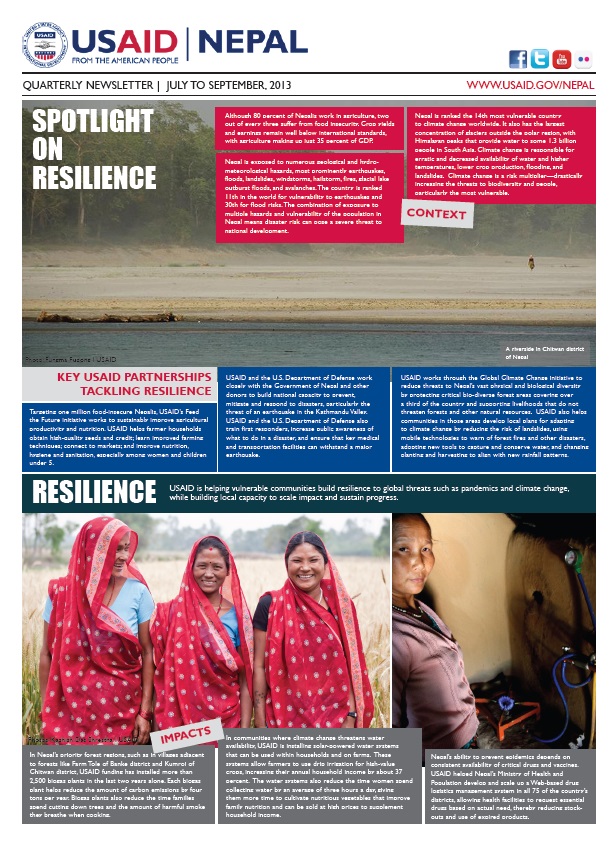Dear colleagues,
The second edition of USAID Nepal quarterly newsletter is finally here with new stories from the field and reports on development issues.
The ‘Spotlight’ section throws light on how USAID is helping vulnerable communities in Nepal build Resilience to global threats while building local capacity to scale up impact and sustain progress. Similarly, the Science, Technology, Innovation and Partnerships page showcases how USAID is forging partnership that leverage resource and harness the science, technology and innovation that exists throughout the region to enhance development outcomes and maximize impact.
Learn about how USAID and its development partners played a role in support of the recent and much-anticipated Constituent Assembly elections on page 3.
Since August, we’ve been commemorating the 20th anniversary of USAID’s partnership with the Government of Nepal, along with other donors, to combat HIV/AIDS through a series of special events. For example, USAID seized the opportunity to mark the government-led 19th National Condom Day on October 19 by further spreading the message on correct and consistent condom use and promote HIV testing. Check our facebook page to see the highlights. In an exclusive article titled ‘Reflecting Back on the Early Days of USAID’s 20-Year Support to the HIV Response in Nepal’, Mr. Ram Hari Neupane, who first joined USAID’s AIDSCAP project in 1995, talks about the challenges and risks of working as a field staff while on a mission to raise public awareness on HIV/AIDS in a hostile environment.
Did you know that Nepal has one of the highest rates of under-5 undernutrition in the world? Read ‘A Second Chance: Raising Healthy Children with USAID’s Support’ to get an understanding of how Nepali women in rural parts suffer from pregnancy and childbirth-related deaths through Mina's poignant story and how USAID’s project is working to change the lives of women like Mina.
Do take the time to read ‘Saving Lives and Livelihoods, and the Planet – One Village at a Time’ on page seven. It’s a fascinating story on how USAID efforts are enabling Nepal’s poorest and most vulnerable people and villages to build the resiliency they need to thrive, including by conserving biodiversity, mitigating greenhouse gas emissions, adapting to a changing environment and sustainably managing their natural resources.
The most crucial factor in reducing a community's risk from an earthquake is the adoption and enforcement of up-to-date building codes. The U.S. and Nepali Governments are working together to develop an effective mechanism for building code implementation. Read 'Implementing Building Codes to Save Lives' for more on page 8.
Don’t forget to log in to our facebook and twitter pages for latest updates on our programs and stories.
Sheila Lutjens
Acting Mission Director, USAID Nepal









Comment
Make a general inquiry or suggest an improvement.